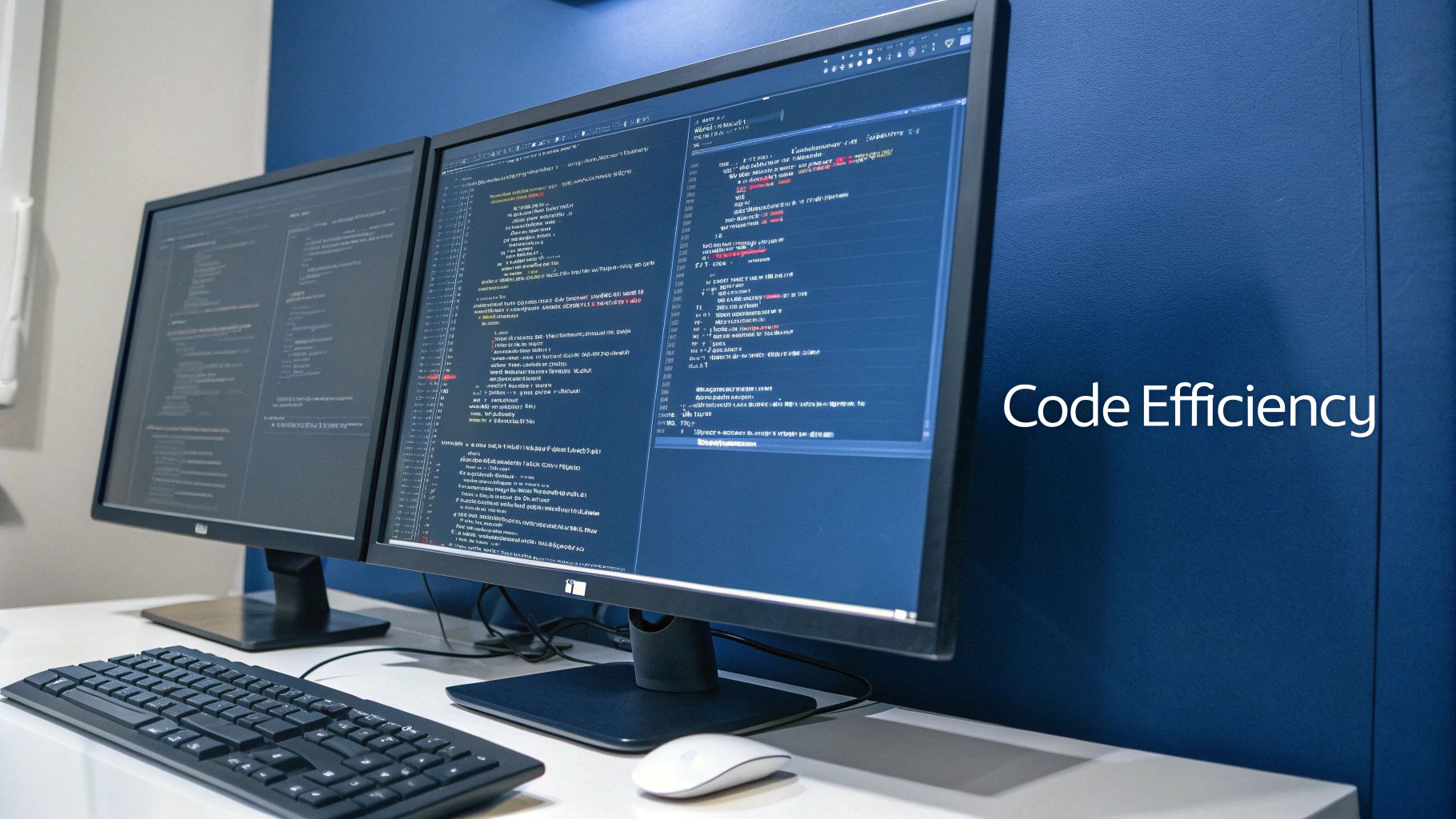15 Best Web Development Tools That Will Revolutionize Your Workflow in 2024
The New Wave of Development Tools: What's Actually Worth Your Time
With new development tools constantly emerging, it can be tricky to figure out which ones are truly useful and which are just temporary hype. Developers need practical ways to evaluate these tools and determine if they're worth adding to their workflow. Let's look at some promising new tools like Cursor and Bolt.new to see how they might improve the way we build for the web.
AI-Powered Coding: A New Frontier
AI coding assistants are changing how developers write code. Take Cursor, for example – it builds AI capabilities right into your coding environment to help with code completion and refactoring. When you're writing a complex function, the AI can suggest better ways to structure your code or point out potential bugs as you type. This not only speeds up development but also helps write better code. For developers learning new languages or frameworks, these AI assistants can explain concepts and provide relevant examples right when needed.
Streamlined Workflows with Integrated Platforms
Tools like Bolt.new are trying to simplify development by bringing key tasks into one place. Think of it as having your essential dev tools organized in a single dashboard instead of jumping between different windows and apps. But for these platforms to be truly useful, they need to work smoothly with the tools developers already use and love, without making things more complicated than they need to be.
Evaluating the True Impact of New Tools
Before jumping on board with new tools, it's important to look at their real-world benefits. The key isn't just what fancy features they offer, but how they actually make development better and solve real problems. A good way to test this is by trying them out on small projects first and measuring things like how much faster you can work, whether code quality improves, and if developers actually enjoy using them. You also need to consider how long it will take your team to learn and get comfortable with a new tool – some provide instant value, while others need more time and training to be worthwhile.
Balancing Innovation with Established Practices
Just because new tools come along doesn't mean we should throw out what already works well. Often, the best approach combines new capabilities with trusted methods. For example, while AI code completion is helpful, it works best when developers understand core programming concepts. Similarly, all-in-one platforms can make workflows smoother, but sometimes specialized tools are still better for specific tasks. The goal is to build a development setup that helps you work efficiently and write great code, using both new and proven tools where they make the most sense.
Next-Generation Code Editors: Beyond Basic Features
Code editors have come a long way from basic text editing and syntax coloring. Modern code editors are becoming powerful workstations that help developers write better code faster and with fewer errors. Let's explore how these tools are changing the way developers work and what capabilities they bring to your daily coding workflow.
The Rise of AI-Powered Coding Assistants
Building on foundations laid by established editors like VS Code, newer editors like Cursor are bringing AI capabilities directly into the coding environment. This goes far beyond simple code completion – these assistants can generate entire code blocks based on natural language descriptions, suggest alternative implementation approaches, and explain complex code patterns. For developers learning new technologies or working with unfamiliar codebases, it's like having an experienced mentor right in the editor, ready to offer guidance and suggestions.
Streamlining Workflows with Integrated Environments
While AI transforms code writing, platforms like Bolt.new are tackling another challenge – bringing key development tools together in one place. By combining common tasks in a single interface, these environments help developers stay focused without constantly switching between applications. The key is finding the right balance – offering useful integrations while maintaining compatibility with specialized tools that teams depend on. This allows developers to build custom workflows that match their needs.
Cursor: A Deeper Dive into AI-Assisted Development
Cursor stands out by deeply integrating AI capabilities into the core editing experience. Beyond basic code suggestions, it can help refactor code based on plain English descriptions, generate documentation automatically, and spot potential bugs early. This means less time spent on repetitive tasks and more focus on solving interesting problems. While AI assistance doesn't replace solid development skills, it amplifies what developers can accomplish by handling routine work more efficiently.
Balancing Innovation with Practicality: Choosing the Right Editor
With so many options available, selecting the right editor requires careful consideration. The most important question is whether a tool genuinely improves your workflow or just adds unnecessary complexity. A good approach is testing new editors on smaller projects first to see their real impact. The goal is building a development environment that helps you work better while maintaining reliability. Focus on tools that solve actual problems you face rather than chasing every new feature.
Emerging AI Development Assistants
Web developers now have powerful new AI companions at their fingertips. Tools like GitHub Copilot, Amazon CodeWhisperer, Cursor and Bolt.new join developers in their daily work. These AI assistants help with repetitive tasks so developers can spend more time solving interesting problems.
AI-Powered Coding: From Suggestion to Generation
Early AI coding tools would suggest the next few characters as you typed. Now, they can write entire functions and documentation based on plain English descriptions. Say you need a function to validate email addresses – just describe what you want in regular words and the AI will write the code in your preferred language. This is especially helpful for common programming patterns that developers write over and over.
The Rise of Integrated AI Development Environments
Tools like Cursor take things further by weaving AI directly into your code editor. Beyond simple suggestions, they help clean up messy code, create tests, and explain confusing sections. Picture asking your editor to "make this function more readable" or "write tests for this code" and having it handle those tasks automatically. This frees developers to think about bigger design decisions.
Bolt.new and the All-in-One Development Platform Approach
Bolt.new shows another way forward – bringing coding, testing, debugging and deployment into one place with AI help throughout. Having everything in a single tool means less time switching between windows and wrestling with different programs. Developers can stay focused on building rather than managing their tools.
Navigating the Limitations and Ensuring Code Quality
While these AI assistants are helpful, they aren't perfect. They sometimes write buggy or inefficient code, especially for unique or complex tasks. Smart developers treat AI suggestions as helpful starting points that need review, not finished solutions. Tools like DebugBar remain essential for thorough testing, regardless of how the code was written.
The Future of AI in Web Development: A Collaborative Approach
Looking ahead, web development will likely be a partnership between human creativity and AI assistance. The AI tools excel at routine tasks and starter code, giving developers more time for creative problem-solving. But developers' expertise in reviewing code quality, maintainability and project needs remains crucial. As these tools improve, they'll become natural extensions of how we build for the web – helpful partners rather than replacements.
Modern Frameworks and CMS Tools That Actually Deliver
Web development relies on solid foundations – frameworks and Content Management Systems (CMS) power the vast majority of sites and applications we use daily. Let's examine which tools consistently prove their worth through real-world performance and developer experience.
The Reign of WordPress and Its Ecosystem
WordPress stands strong as the backbone of the web, running 43.1% of all websites. This remarkable adoption stems from its proven reliability and rich ecosystem of extensions. Beyond the core platform, solutions like WooCommerce for online stores and Elementor for visual page building let developers create full-featured sites efficiently. The sheer number of available plugins shows how WordPress continues to meet real business needs across industries.
Modern Frameworks: React, Vue, and Angular
While WordPress excels at content management, JavaScript frameworks like React, Vue.js, and Angular provide the building blocks for smooth, interactive web apps. React's component system and virtual DOM help create snappy user interfaces. Vue.js offers an approachable entry point for smaller projects. Angular brings Google's engineering prowess to enterprise-scale applications. Each framework serves different needs well, giving teams options based on their specific requirements.
The Emergence of Cursor and Bolt.new: A New Approach?
New tools like Cursor and Bolt.new aim to improve development workflows through AI assistance and unified platforms. Cursor helps automate common coding tasks right in the editor. Bolt.new combines coding, testing and deployment in one place. While these tools show promise, their success depends on how well they fit into existing development practices and deliver real productivity gains.
Choosing the Right Tool: A Balanced Decision
Picking development tools requires careful consideration of project scope, team capabilities, and long-term maintenance needs. WordPress remains ideal for content-focused sites. For complex applications with rich interactions, frameworks like React, Vue, or Angular often work better. Many projects benefit from combining platforms – like using WordPress to manage content while adding a React frontend for interactive features. This practical approach lets teams use the best tool for each part of the solution.
As newer options like Cursor and Bolt.new mature, they may earn a place in development workflows. The key is evaluating tools based on how they solve real problems and help teams build better websites more efficiently. By focusing on practical benefits rather than hype, developers can make informed choices that set projects up for success.
Collaboration Tools That Transform Team Productivity
Great websites come from teams working well together. While code quality matters, smooth communication and coordination between team members often makes the difference between success and failure. Let's look at how tools like GitHub, Cursor, and Bolt.new help teams work better together.
Version Control and Code Management: The Foundation of Collaboration
Good teamwork starts with solid version control. GitHub gives teams a central place to track code changes, manage issues, and review each other's work through features like pull requests. This means multiple developers can work on code at the same time without stepping on each other's toes, while keeping a clear record of who changed what and why. On the design side, tools like Figma let designers work together in real-time and share their work directly with developers, making the hand-off process much smoother.
Streamlining Communication and Feedback: Beyond Email
Too many emails can slow teams down and lead to confusion. That's why teams are moving to better ways to communicate. For example, Slack keeps all project discussions in dedicated channels and direct messages, with easy file sharing all in one place. Instead of digging through long email chains, team members can quickly search past conversations to find what they need. This means faster answers to questions and quicker feedback on work, helping everyone stay productive.
Emerging Tools: AI and Integrated Platforms
New AI tools like Cursor and Bolt.new are changing how teams work together. Cursor builds AI help right into code editing, making it easier for developers to work in pairs and review code together. The AI can spot potential problems and suggest improvements during coding sessions. Bolt.new brings coding, testing and deployment into one place, helping teams see and work on different parts of the project more easily. These tools not only help individual developers work faster but also make it easier for team members to share knowledge and stay in sync.
Building a Collaborative Culture: Process and Tools
The best tools only work well when teams use them as part of clear processes. This means setting up standard ways to communicate, review code, and give feedback. For instance, many teams require peer review through GitHub pull requests before any code goes into the main project. This helps catch issues early and lets team members learn from each other's work. When teams combine good tools with solid processes, they can work together much more effectively and deliver better results.
Performance Optimization Tools Worth Your Investment
Website performance directly impacts user satisfaction and business success. Even the most beautifully designed sites can fail if they're slow or unresponsive. Let's look at the key performance optimization tools that can help you deliver faster, more reliable web experiences.
Understanding the Performance Landscape
Performance optimization involves many interconnected elements – from server response times and database efficiency to frontend loading speeds and asset delivery. Like instruments in an orchestra, each component needs proper tuning to create a smooth user experience. When one element lags, like an oversized image or slow database query, it affects the entire site's performance.
Frontend Performance Powerhouses
Google PageSpeed Insights examines your site's frontend performance and provides specific recommendations for improvement. It analyzes factors like image sizes, caching setup, and loading sequences, then suggests practical fixes. For example, it might recommend compressing large images or adjusting cache settings to speed up repeat visits – small changes that make a big difference, especially on slower connections.
Browser developer tools are essential for detailed performance analysis. These built-in features help developers track network activity, measure rendering speeds, and monitor JavaScript execution. With this granular data, teams can quickly spot and fix performance bottlenecks.
Backend Performance Boosters
For backend optimization, services like New Relic track server performance, database operations, and overall application health in real-time. They show exactly where slowdowns occur – like problematic database queries that need indexing improvements. This ongoing monitoring helps catch issues early before they impact users.
Integrating Performance into Development Workflows
AI-powered tools are making development more efficient. Cursor speeds up common coding tasks, while Bolt.new combines coding, testing and deployment in one platform. But tool adoption alone isn't enough – performance testing needs to be part of the daily development process. Tools like DebugBar give developers immediate feedback about performance issues right in the browser. By making performance a priority from the start, teams can build sites that are both visually appealing and fast-loading.
Want to improve your website's speed and reliability? DebugBar gives you the insights needed to identify and fix performance problems. Visit DebugBar today to start building faster web applications that your users will love.




Comments
Leave a comment